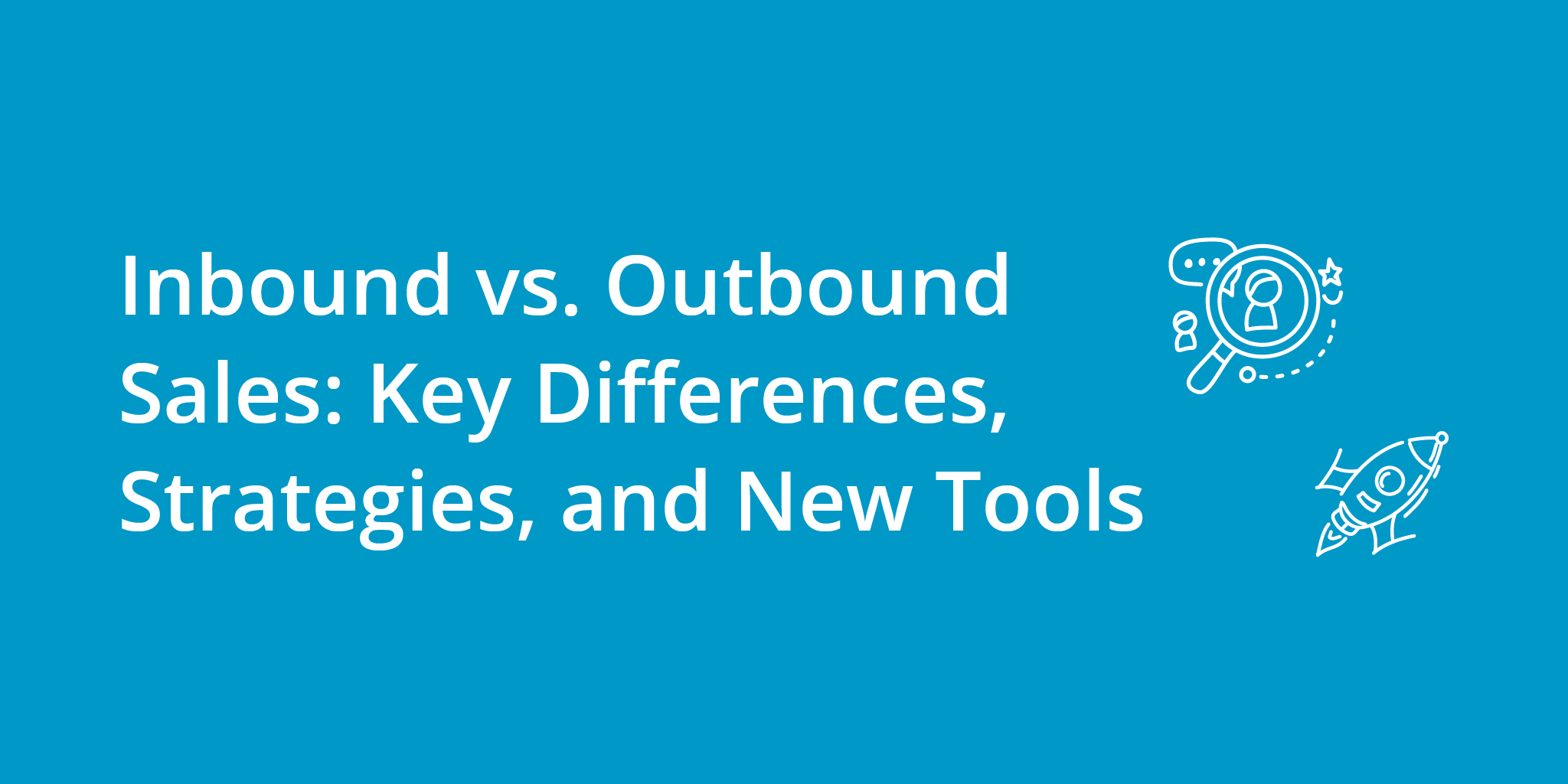
Understanding the nuances between inbound and outbound strategies is crucial for any business aiming to maximize its revenue potential. Both strategies are evolving with the advent of new AI and automation tools, which are reshaping the landscape of customer engagement.
In this article, we delve into the distinguishing features of these sales approaches, explore their respective strategies, and highlight the impact of AI-powered software on sales processes.
What’s the Difference Between Inbound and Outbound Sales?
Inbound Sales Definition
Inbound sales refer to a sales process where potential customers initiate contact with a company to inquire about or purchase its products or services. This approach is customer-centric and focuses on addressing the needs and interests of prospects who have already shown interest in the company’s offerings.
In inbound sales, the sales team’s role is to guide and assist prospects who reach out to the company through various channels, such as website inquiries, emails, social media, or phone calls. Unlike outbound sales, where sales representatives proactively reach out to potential customers, inbound sales involve responding to and nurturing leads that come to the company.
This method relies heavily on creating valuable content and experiences tailored to the customer’s needs and stage in the buying journey. It’s about understanding and solving the problems of potential customers, providing them with the information they need to make informed decisions, and building relationships based on trust and expertise.
Outbound Sales Definition
Outbound sales refer to the traditional sales approach where sales representatives initiate contact with potential customers. This method is characterized by proactive efforts by the sales team to reach out to prospects who may not have expressed prior interest in the company’s products or services.
In outbound sales, the sales process typically involves activities such as cold calling, emailing, direct mail, and attending trade shows or networking events. The goal is to introduce the company’s offerings to potential customers, create interest, and ultimately convert them into buyers.
This sales strategy requires a good understanding of target markets and customer profiles, as sales reps need to identify and contact individuals or businesses that are likely to be interested in what the company has to offer. It’s often more aggressive and direct compared to inbound sales, focusing on the salesperson’s ability to persuade and close deals.
Outbound sales can be challenging because it involves reaching out to people who may not have a prior relationship with the company or awareness of its products. Therefore, it requires strong communication skills, persistence, and effective strategies to capture the attention of potential customers and convince them of the value of the products or services being offered.

Inbound vs. Outbound Sales: Key Differences
- Inbound sales focuses on creating demand for the business’ products and services, and is marketing-centric.
- Inbound sales creates value and interest around the business’ offerings, encouraging interested customers to initiate contact with the company.
- Outbound sales is more traditional and relies on the business reaching out to potential customers first.
- Outbound sales often involves cold calling, cold emailing, direct mail, and attending events or trade shows.
Strategies for Inbound vs. Outbound Sales
If you’re aiming to implement an inbound and an outbound sales motion within your organization, it’s important to create a winning strategy. Here are some inbound and outbound sales examples, along with strategy considerations for each.
How to Create Winning Inbound Sales Strategies
Successful inbound sales strategies are focused on attracting, engaging, and delighting potential customers who have shown interest in a company’s products or services. These strategies are designed to nurture leads through the sales funnel by providing value and building trust. Here are three examples:
- Content Marketing and SEO: A robust content marketing strategy combined with search engine optimization (SEO) is crucial in attracting potential customers. By creating valuable and relevant content (such as blog posts, e-books, webinars, and infographics) that addresses the needs and questions of your target audience, you can draw them to your website. Effective SEO ensures that this content ranks well in search engine results, making it easier for potential customers to find your business when they’re looking for solutions you offer.
- Personalized Email Marketing: Once a lead has shown interest, personalized email marketing can be a powerful tool. This involves sending tailored emails based on the lead’s behavior, preferences, and stage in the buyer’s journey. For instance, if a prospect downloads an e-book from your website, you can follow up with emails that provide additional, related information or offer a consultation. Personalization increases the relevance and effectiveness of your communication, fostering a deeper connection with the lead.
- Responsive Sales and CRM Utilization: Quick and helpful sales representatives are vital in converting inbound leads. Utilizing Customer Relationship Management (CRM) tools, you can track interactions with prospects and provide timely, personalized responses to their inquiries. This approach ensures that potential customers feel valued and understood, increasing their likelihood of choosing your company over competitors. Additionally, CRM tools help segment and manage leads effectively, allowing sales teams to prioritize and focus on the most promising opportunities.
Each of these strategies revolves around understanding and meeting the needs of potential customers who are already interested in your company’s offerings, thereby increasing the chances of converting them into paying customers.
How to Craft High-Performance Outbound Sales Strategies
Effective outbound sales strategies are designed to reach and engage potential customers who may not be aware of a company’s products or services. These strategies typically involve proactive outreach tailored to generate interest and drive sales. Here are three examples:
- Targeted Cold Calling with Pre-qualified Leads: Cold calling can be a highly effective outbound sales strategy when executed with a focus on pre-qualified leads. This involves researching and identifying potential customers who fit the ideal customer profile and are likely to benefit from the product or service. Sales representatives should be well-prepared with information about the lead, including their business needs and potential challenges, to make the call more personalized and relevant. The goal is to engage the prospect in a meaningful conversation, identify their pain points, and present the product or service as a solution.
- Social Selling and Networking: Utilizing social media platforms, especially LinkedIn for B2B sales, allows sales representatives to connect with and engage potential clients. Social selling involves building a professional brand, sharing valuable content, participating in industry discussions, and directly reaching out to prospects through these platforms. It’s a more subtle and relationship-focused approach than traditional cold outreach, aimed at establishing trust and credibility before pitching a product or service. Networking at industry events, trade shows, and conferences also falls under this strategy, providing opportunities to make personal connections with potential clients.
- Strategic Email Campaigns: While similar to email marketing in inbound strategies, outbound email campaigns are more direct and less personalized initially. These campaigns involve sending well-crafted, persuasive emails to a list of potential leads. The emails should be attention-grabbing, concise, and clearly convey the value proposition of the product or service. Follow-up emails are crucial in this strategy, as they keep the conversation going and increase the chances of a response. Segmenting the email list based on industry, role, or other relevant criteria can enhance the effectiveness of the campaign.
In all these strategies, the key is to focus on the value and solutions that the product or service can provide to the potential customer. Effective outbound sales require persistence, a deep understanding of the target audience, and a clear communication of how the offering addresses specific needs or problems.

Sales Tools for Inbound and Outbound Sales Success
Both inbound and outbound sales strategies require a set of specialized tools to maximize efficiency and effectiveness. Here’s a description of some essential tools, including their definitions and roles in sales processes:
For Both Inbound and Outbound Sales
- CRM (Customer Relationship Management) based routing: This tool is pivotal in managing customer interactions and data throughout the customer lifecycle. CRM-based routing specifically refers to the process of directing incoming calls or inquiries to the most appropriate sales representative based on predefined criteria stored in the CRM system. This could include factors like the customer’s location, purchase history, or specific needs.
- Sales Intelligence Platform: As both inbound and outbound sales become more complex with multiple buying decision makers and influencers through the funnel, sales intelligence platforms become the lifeblood of the CRM. A sales intelligence platform combines vital information such as contact and company information including emails, and phone numbers; technographic and firmographic data such as the technologies being used within an organization, the organization’s size, revenue, and so on, buyer intent data and much more. This provides sales and marketing teams the information they need to find their ideal customers, know what and when they are looking to purchase, and reach out to them before their competition.
Primarily for Inbound Sales
- IVR (Interactive Voice Response): IVR systems are used to manage incoming calls by providing automated responses to callers. Callers can interact with the IVR through voice commands or keypad inputs, allowing them to choose from various options (e.g., speak to sales, customer support, etc.). IVR helps in efficiently routing calls to the appropriate department or individual.
Primarily for Outbound Sales
- Sales Dialer: This is a tool used in call centers and by sales teams to automate the process of dialing phone numbers. It helps sales reps make calls more efficiently by eliminating the need to manually dial numbers, thus saving time and reducing errors.
- Power Dialer: A power dialer is an advanced type of sales dialer. It automatically dials numbers from a predetermined list of contacts at a consistent pace, one after the other. As soon as a call is finished, the next call is automatically dialed. This tool is highly efficient for sales teams as it reduces idle time between calls.
- Prioritized Powerlists: This tool involves creating a prioritized list of contacts for the power dialer to call. The prioritization can be based on various factors like lead score, customer behavior, or likelihood to buy. This ensures that the sales team’s efforts are focused on the most promising leads first.
- Local Presence Dialing: This feature allows sales representatives to display a local phone number on the recipient’s caller ID, even if they’re calling from a different region or country. This can increase the likelihood of the call being answered, as people are more likely to respond to local or familiar numbers.
New AI and Automation Tools
The integration of AI and automation in sales tools is revolutionizing how sales teams operate, making processes more efficient and data-driven. Here are some advanced tools incorporating AI and automation technologies:
- ConnectionBoost: ConnectionBoost is a feature unique to Kixie PowerCall that aims to increase the likelihood of successfully connecting with potential customers, thereby improving the efficiency of outbound calling campaigns. It uses AI algorithms to dynamically choose phone numbers more likely to be answered on outbound calls.
- Multi-line Power Dialer with Human Voice Detection: This tool is a more sophisticated version of a standard power dialer. A multi-line power dialer can call multiple leads simultaneously, significantly increasing the number of calls a sales rep can make in a given period. The human voice detection feature is particularly noteworthy – it uses AI to detect when a human, as opposed to a voicemail system, answers the call. This ensures that sales reps are connected only when there’s a real person on the other line, thereby maximizing productive talk time and reducing time wasted on unanswered or irrelevant calls.
- Conversation Intelligence: Conversation Intelligence tools use AI to analyze sales calls. They can transcribe conversations, identify key points and topics, and provide insights into customer sentiments and sales rep performance. This technology can detect patterns in conversations, such as commonly raised objections or frequently asked questions, and suggest improvements or training needs for sales reps. Additionally, it can provide real-time assistance to sales reps during calls, such as suggesting responses or pulling up relevant product information.
These tools are not just about automation; they’re about making sales interactions smarter and more strategic. By leveraging data and AI, they help sales teams to be more effective in their outreach, understand their customers better, and continually improve their sales processes.
Start Improving Your Inbound and Outbound Sales Efforts Today
While inbound sales leverage the power of customer-initiated interest with a focus on content and relationships, outbound sales rely on proactive outreach to spark interest and create new customer opportunities.
As the landscape of sales continues to evolve, the successful integration of inbound and outbound methodologies, complemented by cutting-edge tools, will be key to achieving sustainable growth and success.
Kixie PowerCall offers all of the inbound and outbound sales tools mentioned within this article. With affordable mix-and-match plans, our solutions are easy to implement for sales teams of all sizes. Get started with a free, 7-day trial of Kixie’s advanced sales dialer with ConnectionBoost, CRM based routing, IVRs, and more.
You might also be interested in...

Read More
What is Revenue Operations?





